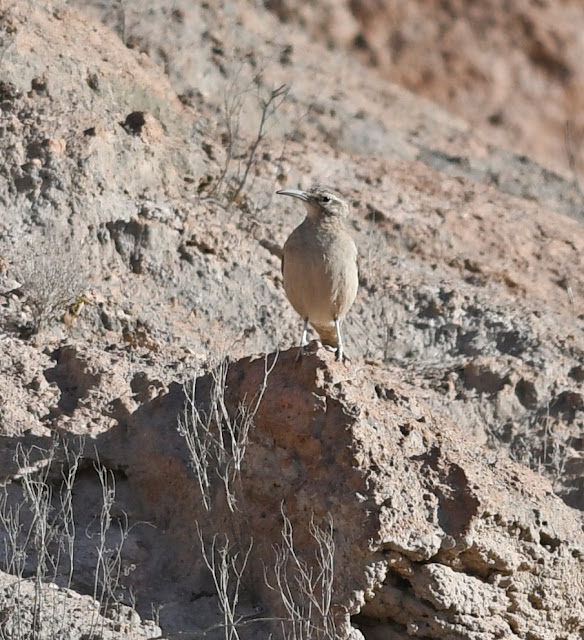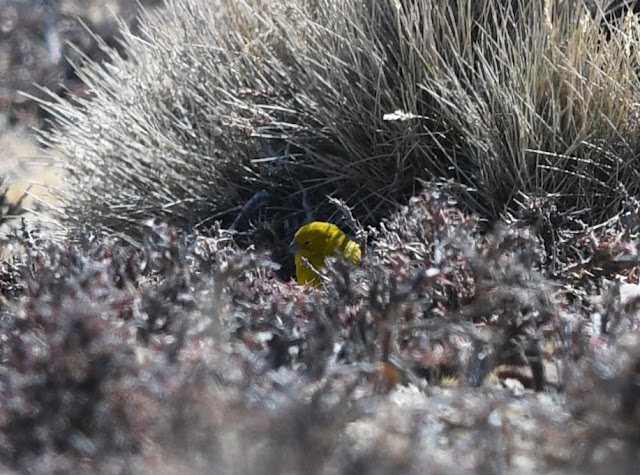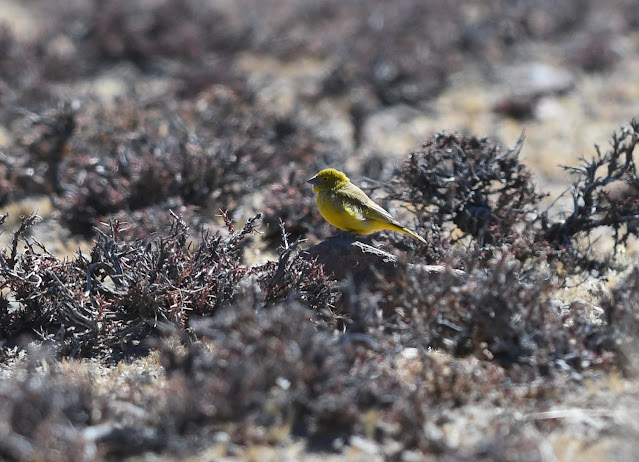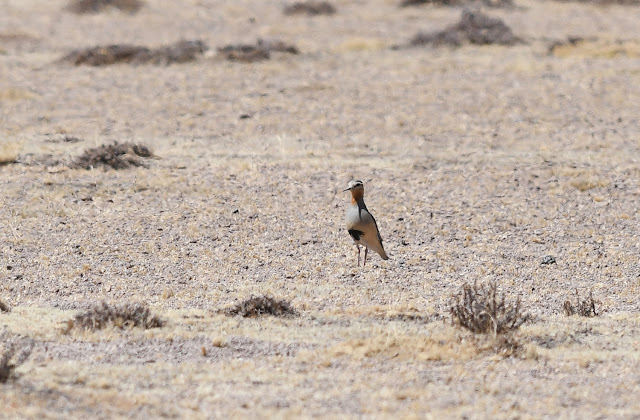August 16 (continued)
We headed eastwards with a plan to spend the next leg of the trip near the town of Puno, situated on the shores of Lake Titicaca. This lake is famous for holding the majority of the world's Titicaca Grebes, while the high-elevation puno habitat surrounding the lake is home to many other interesting birds. To break up the drive, we spent a night outside of Arequipa in the uninspiring town of Yura. We made good time on our drive to Yura from the Pacific coast, giving us a few hours to search for some birds in the hills outside of town.
 |
| Yura area, Arequipa, Peru |
A few days earlier when Laura and I were still finishing up our four-week tour of central Peru, we experienced car problems which prevented us from visiting Lomas de Lachay. Several key species find habitat in that surprisingly green environment, an island of sorts in the desert, including the Cactus Canastero, Grayish Miner and Thick-billed Miner. Luckily, we had a second chance at these species outside of Yura. It was a beautifully calm, sunny afternoon when we arrived at the site.
 |
| Yura area, Arequipa, Peru |
Everything went perfectly to plan. Grayish Miners were abundant in this area and we saw flocks of them along the roadside on the drive in. I never managed a good photo of one, though.
 |
| Grayish Miner - Yura area, Arequipa, Peru |
We heard the distinctive calls of a Thick-billed Miner and were quickly rewarded with good views of it. A well-named bird.
 |
| Thick-billed Miner - Yura area, Arequipa, Peru |
We kept an ear out for Cactus Canasteros as we walked. Other creatures distracted us during our search, including some Streaked Tit-Spinetails and a Peru Pacific Iguana. Not surprisingly, nearly every animal here is varying shades of gray and brown, blending in perfectly to their environment.
 |
| Streaked Tit-Spinetail - Yura area, Arequipa, Peru |
 |
| Peru Pacific Iguana (Microlophus peruvianus) - Yura area, Arequipa, Peru |
We locked onto a pair of Cactus Canasteros just before arriving back at the car. This species has a limited range on arid slopes in western Peru and it is frequently found near columnar cacti, in which it nests.
 |
| Cactus Canastero - Yura area, Arequipa, Peru |
That evening, we returned to the town of Yura where we found a hotel room for the prices of 30 soles (around 10 Canadian dollars).
August 17, 2022
Given the success of the previous afternoon, Laura and I were not in a rush this morning. We completed the drive eastwards to Lake Titicaca, making a number of birding stops along the way.
The first stop was high in the puno habitat near the town of Patahuasi, situated within a national reserve that reportedly protects a substantial population of wild Vicuñas. We were keen to look for a few birds in this bunchgrass habitat including Puna Tinamou, Puna Yellow-Finch and Golden-spotted Ground-Dove.
 |
| Patahuasi, Arequipa, Peru |
It was rather windy and the tinamous were not vocalizing. We were unable to flush any up out of the grass, either. However, one of the first birds that we spotted was a Golden-spotted Ground-Dove that allowed a close approach. Though it is a rather plain species, the golden shoulders really "pop" in good light!
 |
| Golden-spotted Ground-Dove - Patahuasi, Arequipa, Peru |
Several whirling flocks of yellow-finches kept us occupied but they appeared to only contain a common, widespread species: Bright-rumped Yellow-Finch. A little later we spied a pair of yellow-finches keeping to themselves at the edge of the creek. They exhibited the bright yellow plumage characteristic of Puna Yellow-Finch!
 |
| Puna Yellow-Finch - Patahuasi, Arequipa, Peru |
 |
| Puna Yellow-Finch - Patahuasi, Arequipa, Peru |
We gave up on the tinamous and continued with the long drive. The scenery was spectacular - impressive mountain peaks in the distance and Vicuñas dotting the bunchgrass plains below. In typical fashion, clouds of plastic garbage littered the roadways and nearby bunchgrass, taking away from the scenery.
While scanning for tinamous from the car, Laura noticed some peculiar shapes in a stony area with limited vegetation. Tawny-throated Dotterels! These handsome shorebirds live in windswept open plains from Patagonia to the high Andes. They are never really common, and in fact these were the only ones we would encounter in Peru.
 |
| Tawny-throated Dotterel - Imata area, Arequipa, Peru |
 |
| Tawny-throated Dotterel - Imata area, Arequipa, Peru |
In the high Andean plains in this part of Peru, birdlife can be hard to come by. You may spot the odd Mountain Caracara or flock of yellow-finches, perhaps see a ground-tyrant perch up on a rock or maybe a distant soaring Variable Hawk. But generally, it is cold, windswept and birdless. That is, until you come across a wetland. High-Andean lakes are chock-full of life, with hundreds of coots, ducks, geese, gulls and more taking refuge in these productive habitats. Flamingos are a common sight, shorebirds are often present, and a nice variety of flycatchers can be easily found.
We stopped at several of these wetlands along the drive. Keeping the scope steady in the wind was a challenge but we came away with some great sightings. An early highlight was a pair of Puna Plovers, a new species for both of us.
 |
| Puna Plover - Laguna Lagunillas, Puno, Peru |
At 66 square kilometers, Laguna Lagunillas is massive and home to substantial populations of ducks, coots, flamingos and other birds. We spent some time here as well and were impressed with its birdlife.
 |
| Laguna Lagunillas, Puno, Peru |
Up to this point, we had only seen one of Peru's three flamingo species: the Chilean Flamingo. But at Laguna Lagunillas we found good numbers of Andean Flamingos and a small group of attractive James's Flamingos as well!
 |
| James's Flamingo (center) with Andean Flamingo (left) and Chilean Flamingos |
The Andean Flamingo is listed by Birdlife International as Vulnerable due to its rapidly decreasing population, mainly caused by declines in habitat quality. They only live in high-elevation salt lakes and bogs in the southern Andes. Andean Flamingos are easily identified by their yellowish legs and black "triangle" caused by their dark primaries when at rest.
 |
| Andean Flamingo - Laguna Lagunillas, Puno, Peru |
The James's Flamingo is also a listed species by Birdlife International, but its status is one rung lower at Near Threatened. While once a species in steep decline, populations appear to be relatively stable since the 1990s.
 |
| James's Flamingos - Laguna Lagunillas, Puno, Peru |
 |
| James's Flamingo - Laguna Lagunillas, Puno, Peru |
The flamingos provided an excellent study but there was excitement to be found with the shorebirds as well. The big highlight was our first pair of Andean Avocets, another denizen of high-Andean salt lakes. As you can see, the lighting was just perfect for these photos...
 |
| Andean Avocets - Laguna Lagunillas, Puno, Peru |
 |
| Puna Plovers - Laguna Lagunillas, Puno, Peru |
 |
| Baird's Sandpiper - Laguna Lagunillas, Puno, Peru |
That afternoon, we completed the drive to Puno and settled in to our AirBnB apartment, home for the next few nights. It had been a good day.

No comments:
Post a Comment